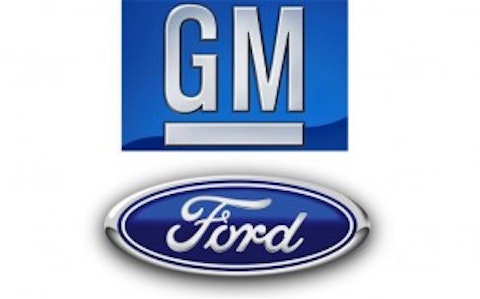
Cars like the Cadillac CTS-V are much more important to their makers than their tiny sales numbers would indicate.
Photo credit: General Motors Company (NYSE:GM)
Ever wonder why so many automakers build fast, expensive cars?
Here’s a clue, starting with the latest news from Germany’s Audi brand.
Answering the prayers of a tiny band of well-heeled car nerds around the world, Volkswagen (NASDAQOTH:VLKAY)‘s Audi brand said that it will speed up future launches of its hyper-fast (and hyper-expensive) RS lineup of high-performance cars.
Audi sales chief Luca de Meo told reporters at the Shanghai Auto Show on Saturday that the move to bring future RS models to market sooner would help it boost profits.
That’s a big priority for Audi, as the already very profitable brand works to close a pricing gap between it and German rivals BMW and Mercedes-Benz.
But does it matter to the rest of us? Audi’s RS models can cost $100,000 or more, and they sell in tiny numbers. Who cares, beyond those few rich car nerds and a few German auto executives?
I bet General Motors Company (NYSE:GM) cares, for starters. Here’s why.

Audi’s RS models don’t sell in big numbers. In the grand scheme of things, neither do their German counterparts, Mercedes’ AMG models and BMW’s somewhat more famous M line of vehicles.
But they’re important to the businesses in other ways. In fact, high-performance “halo” cars are so important to luxury brands that General Motors Company (NYSE:GM) pushed to get the second-generation of its hot Cadillac CTS-V sedan to market in late 2008 – when it was quickly spiraling down the drain toward bankruptcy.
Why did General Motors Company (NYSE:GM) do that at a moment when it was desperate to conserve cash? There are two big reasons. First, these cars are very profitable: The current Cadillac CTS sedan starts at about $39,000, and a nicely equipped one will run you about $50,000 or so – but the CTS-V can run well over $70,000. That difference is mostly profit.
The CTS and CTS-V are the same basic car, built on the same assembly line in Lansing, Mich. – but the bigger engine and other high-performance features in the V version command a substantial premium in the marketplace, much greater than General Motors Company (NYSE:GM)’s incremental cost to build it.
That’s even more true at Audi, where the RS versions of its sedans can sell for as much as three times the price of the base model.
But neither automaker sells very many of those hot high-performance versions, just as Ford Motor Company (NYSE:F) sells only a few of the super-fast Shelby GT500 versions of its iconic Mustang. The small sales numbers mean that these cars will never add much to their makers’ bottom lines by themselves. But there’s at least one more reason why these cars continue to be an important business for automakers.
The “halo car” effect and residual values
These cars carry a weight in the court of public opinion that goes far beyond their sales numbers. When that CTS-V came out in late 2008, reviewers – some of whom had been very hard on General Motors Company (NYSE:GM) for a long time – hailed it as perhaps the company’s best car ever.
That glowing press probably didn’t sell a whole lot of CTS-Vs (though it sold some), but it did increase the credibility of the mainstream CTS model in the minds of buyers who might otherwise have chosen a German car. It also increased its desirability, and – and this is important, pay attention here – probably increased its resale value.
That’s a big deal to automakers, especially with luxury cars. Why? Because a lot of luxury cars (more than half, with some brands) aren’t actually sold, they’re leased. Automakers’ financing arms lease the cars, and then when the lease ends, they sell the used cars.
The higher the value of those used cars (called the cars’ “residual values”), the lower the overall cost of the lease. Or put another way, when an automaker’s residual values go up, it can offer better lease deals. That attracts more buyers and sells more cars.
That’s why these cars exist, and it’s why they’re in no danger of disappearing any time soon.
The article Why Fast Cars Are Big Business originally appeared on Fool.com and is written by John Rosevear.
Motley Fool contributor and CTS-V owner John Rosevear owns shares of Ford and General Motors. Follow him on Twitter at @jrosevear. The Motley Fool recommends BMW, Ford, and General Motors. The Motley Fool owns shares of Ford.
Copyright © 1995 – 2013 The Motley Fool, LLC. All rights reserved. The Motley Fool has a disclosure policy.


